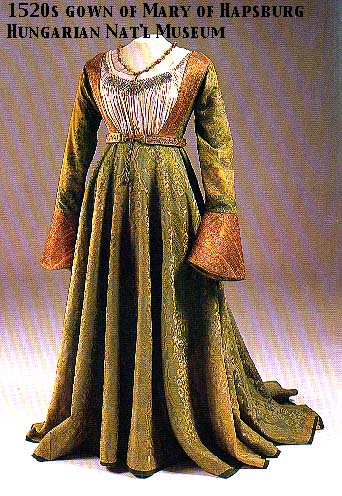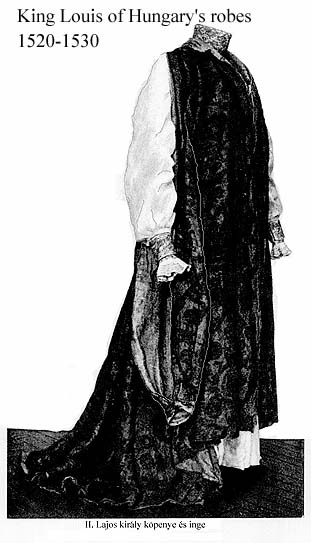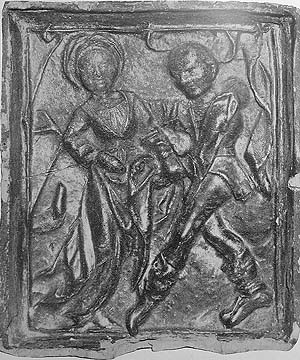

Specifics on these articles:
On Hollrigl's analysis, I only have Ember's vague references to the
fact that it was written in 1929, presumably in Hungarian; I have no idea
where (or if) it was published.
Ember's article appeared in the Hungarian National Museum -- Historical Museum's yearbook, titled Folia Archaeologica XIV, in 1962, published by the Képzõvûvészeti Alap Kiadóvállalata (Publishing Company of the Fine Arts Foundation) in Budapest. The article appears in the yearbook in Hungarian (pages 133-150) and in a short French translation (pages 150-153).
I got my photocopy of Ember's article by writing an email (in Hungarian) to the Hungarian National Museum. (I have no idea what would happen if one wrote to the museum email address in English; I had no reason to try it.) I have Lady Gryphon ui Gilliam to thank (blame? <grin>) for getting me involved in this whole thing. Cynthia put us in touch because Lady Gryphon has been working on re-creating the dress, and I've seen it in person. Lady G sent me the link to the museum's website, which led to my email, which led to the article.

"The cloak is made of a 58 cm wide gold and violet brocade. The cloak is mid-calf length in front, 124 cm long. The back is much longer, 166 cm, forming a slight train. The front pieces are cut from a single width of fabric, falling smoothly from the shoulder. The back is two widths of fabric, gathered onto a 11 cm high yoke. The bell-like width of the cloak is given by the triangular sets of gores sewn into the side seams. The collar is a 10 cm wide rectangle with rounded corners, sewn into the neck opening along its entire length. Also cut from a single width of fabric, the straight sleeves are slit all the way from the shoulder down, 113 cm long, reaching almost to the bottom of the cloak. The bottoms of the sleeves are gathered into 3 cm wide cuffs. "The pieces are sewn together with a scant 1 cm seam allowance, using silk thread and small stitches. The bottom has a quite narrow hem. The collar and front edge are finished with a narrow (scant 1 cm) hem folded outward (to the right side) and sewn down with tiny stitches. This hem technique indicates that the collar and front were worn folded down/outward, showing the brocade's silvery reverse side. The short front/long back indicates the garment was intended to be worn on horseback."
"Louis II's shirt, made of fine linen, is cut very simply. The top yoke is a rectangle, folded at the shoulder, with a neckhole and front slit. This top section is 48 cm wide and 108 cm long. Gathered onto it both front and back is the bottom skirt, which is 90 cm long, and is sewn from 3 rectangles, each 105 cm wide. The side (underarm) seams are left open on the top yoke for a length of 10 cm, presumably to make the shirt easier to put on. The sleeves are simply rectangles, 48 cm wide by 78 cm long, sewn at right angles to the yoke, with 11 cm square underarm gussets. The sleeves are nearly knee length, so they were worn bunched up. The wrist is gathered (smocked) to about 17 cm, with a 5 cm ruffle left below the 1.5 cm wide gathered section. The gathers are secured with gold thread embroidery in a geometric pattern, and the ruffle is decorated with cutwork (punto tirato) along about half its width. The neck opening has an unusually tall (10 cm) collar, made of two layers of linen. The collar and front slit, as well as the sleeves above the gathered section, have a 7 cm wide band of elaborate metalwork embroidery, worked on the same linen material as the shirt. The collar's embroidery is 36 cm long, the front slit's is 21 cm, and the sleeve's is 17 cm. (snip description of embroidery pattern) Each panel of embroidery is edged with narrow gold braid, and lined with green silk, then stitched to the shirt through all layers."
"The blouse's front and back are each made of three trapezoidal pieces. The pieces are 40 cm wide at the top, 60 cm at the bottom. They're attached to each other with 1 cm wide lines of silver embroidery in a blanket stitch. The two sides are widened further by two triangular gores, each 60 cm wide. The three front panels are gathered to a width of 21 cm, forming the front of the neckline. The gathered section is about 6 cm wide [Ed: I think they mean "deep" ie, width of smocking embroidery], secured by geometric satin-stitch embroidery in silver thread. The back sections are also gathered to 21 cm, with embroidery 1 cm narrower than on the front. The long, full sleeves are also assembled from three pieces attached to each other with silver blanket stitch. The sleeves are straight rectangles, 65 cm long, 122 cm wide, with the top sections gathered to 28 cm, and forming the sides of the neckline. The embroidery securing the gathers is only 3 cm wide. The neckline is enclosed in a 3 cm wide band. The wide sleeves are gathered to 24 cm at the wrist, sewn to a 1.5 cm wide cuff. The gathers are decorated with narrow silver embroidery in an interlocking half-circle pattern. The underarm gussets are 25 cm squares. The shirt's material is a closely woven fine evenweave linen."
Here is a Hungarian stove tile dated to 1490 that has a dress which
is very similar.

| © 2001 Cynthia Virtue except as noted | Email Author with comments-I will forward to Julia |
| Back to Virtue Ventures Main Page | Back to Article Index |